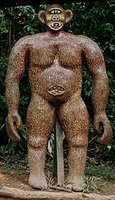
December 14, 2007
Top Ten Bigfoot Stories of 2007
by Loren Coleman, Bigfoot!, and The Field Guide to Bigfoot and Other Mystery Primates.

During 2007, the worldwide interest in unknown hairy human-like creatures moved from a focus in Malaysia in 2005-2006, to more interest again in North American events.
Some of the news was purely organizational and people-driven. Early news out of Texas, for example, told of the establishment of the non-profit Texas Bigfoot Research Conservancy on January 18, 2007. A mid-year announcement mentioned Ray Crowe’s Track Record had ceased publication.
Some news was a mixed bag of local eruptions of various media-created events ~ mostly weekend excursions ~ by Tom Biscardi, Matt Moneymaker, and Erik Beckjord. These localized efforts to drum up press attention in widely diverse locations, whether in California, Florida, Texas, or Alabama, were often short-term, but, nevertheless, kept Bigfoot in the public’s eye throughout the year.
Then by the end of 2007, the attention moved back again to Asia, with reports from China and Nepal.
No matter the local name, the universal term used for any hidden, uncaught, or yet-to-be-verified hairy hominoid, hominid, or anthropoid, anywhere in the world is today “Bigfoot.”
Therefore, the following are the top ten “Bigfoot” stories most discussed on television, on radio talk shows, in blogs, by newspapers, on news programs, in chat rooms, and by many other forms of the media, globally, for 2007:
1. Jacobs Creature Photographs
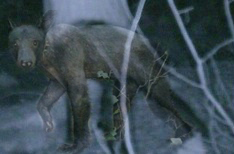
Above: The Jacobs Creature image merged with a Florida state mangy bear photograph.
The number one Bigfoot story of the year, based purely on the fact most people in the general public heard that this event happened, is perhaps the thinnest hominological case of recent memory. It probably is more about a common animal with a disease than an unknown primate, but that did not stop this incident from being discussed as a “Bigfoot.”
In a calculated release of a month-old series of photographs, specifically timed to the date of the 40th anniversary of the Patterson-Gimlin footage (see #2), two Pennsylvania trailcam photographs were given to the media for maximum exposure by the BFRO organization. With no evidence to support the claim, the photos were labeled that of a “juvenile Sasquatch.”
The two images and an accompanying photograph of two bear cubs at the same spot were reported to have been taken on September 16, 2007, by a Bushnell game camera placed in a Pennsylvania forest by a private individual.
The “Jacobs Creature,” as it was called, resulted in ridicule-filled media reports and much debate within the Bigfoot community on the worth of the photographs. From the beginning, Cryptomundo noted the images appeared to be of a “mangy bear”. Anthropologist Jeff Meldrum agreed, as did the Pennsylvania wildlife department. A few folks, nevertheless, saw in the photographs a Bigfoot.
Most people around the world, even with a mild interest in Bigfoot matters, will recall 2007 as the year of this misnamed “juvenile Sasquatch.” Upon reflection, however, the running joke by year’s end for any questionable cryptid photograph was that it was no doubt a known animal with mange.
2. Patterson-Gimlin Footage’s 40th Anniversary
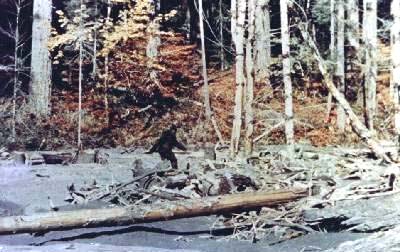
The “background noise” felt all year in Bigfoot circles was of the upcoming four decades milestone of the Patterson-Gimlin film. You had to live in a cave to not know that at Bluff Creek, California, an alleged female Bigfoot was filmed on October 20, 1967, by Roger Patterson and Bob Gimlin.
Because this was the 40th year since that event, Bigfooters talked a great deal about the film as the year opened and moved forward. The forthcoming anniversary had an almost magical quality to it. But the end result was disappointment and frustration.
An attempt was made to have one gathering in California that was cancelled, and another, smaller affair, quickly organized at Willow Creek, came and went.
In general, after the date passed, there was a general letdown that no great conferences or celebrations were able to be organized for the year.
Additionally, many reflected that all that time had gone by without final evidence for the existence of Bigfoot.
Still, the Patterson Bigfoot, affectionally called “Patty,” lives on as an icon and the best piece of evidence for a living Sasquatch. For more, please see here.
3. Yeti Track
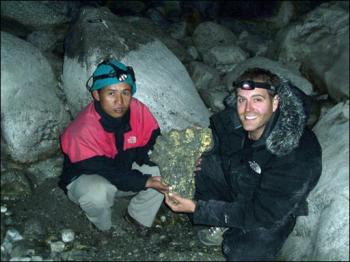
Nine members of a Sci-Fi television production team for the program “Destination Truth,” armed with infrared cameras, spent a week in the icy Khumbu region near where Mount Everest expeditions had passed in the 1950s. On November 28, 2007, moving to a lower elevation of 9,350 feet (2,850 meters), the film crew found the footprints of what they claimed to be a Yeti on the banks of the Manju River.
Host and producer Joshua Gates held a news conference on December 1st in Nepal, and showed the media the casts of two of the three footprints that had been found. The complete footcast (seen above) is about one foot (30 centimeters) long, with an appearance similar to those of other tracks of unknown hominoids found in Asia.
4. Sasquatch DNA
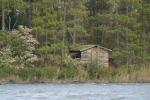
History Channel’s new cryptozoology program MonsterQuest kicked up a lot of interest and press with one November episode, “Sasquatch Attack.” The documentary was about scientists Curt Nelson (biologist, University of Minnesota) and Jeff Meldrum (anthropologist, Idaho State University) spending five days with the show’s film crew at a cabin near Ontario’s Snelgrove Lake (above).
While there, the crew filmed stones flying through the air from an apparent rock-throwing Bigfoot and Meldrum collecting organics from a wooden board with screws in it, used as a bear trap.
The blood, tissue and hair samples discovered on the bear trap outside the cabin were tested. The hair did not match any known North American bear or animal and tests showed, according to the New York Post, “an uncanny similarity to human DNA with one exception: the irregular DNA matched that of a primate,” whatever that meant, considering that humans are primates!
5. Florida “Red Orangutan” Sighting

Beginning in mid-November, local Baker County residents, animal control officers, and Florida Fish and Wildlife folks got caught up in the sightings of a “mysterious ape” near Glen St. Mary, Florida. Animal control officer Tina Thomas, using binoculars, was able to observe what she described as a tree-bound “ball of red fur,” which she took to be like an orangutan.
Despite the descriptions from Baker County people, officially the Florida Fish and Wildlife Department said it was nothing more than a “fox squirrel” and yet they put out a bear trap (above) to catch it. The official who said it was a “fox squirrel” also appears to have been open to calling it a “Skunk Ape” in media conversations.
6. Anthropoidipes ameriborealis

In 2007, Jeff Meldrum (above), Ph. D., Idaho State University, formally published on the tracks of Bigfoot, and gave them a new label, Anthropoidipes ameriborealis (“North American ape foot”), in his paper, “Ichnotaxonomy of Giant Hominid Tracks in North America.”
Meldrum pointed out: “The paper does not validate the existence of Sasquatch, but recognizes the existence of large unidentified tracks and puts a handle on them. This should also increase discussion of the footprint data.”
You can download the paper here: Ichnotaxonomy of Giant Hominid Tracks in North America
7. Nguoi Rung Kidnap Story

Ro Cham H’pnhieng, 27, was discovered on the edge of the Cambodian jungle in January 2007, after she was caught trying to steal food left under a tree. She was seen with a hairy Wild Man, known by the local name, Nguoi Rung (above). Reportedly, she had been kidnapped in 1989 by the wild people and taken into the jungle. Attempts to find the Nguoi Rung were made, with no positive results.
In October 2007, after Ro Cham H’pnhieng’s family tried to have her live with them again, after several incidents of her running away into the forest, she escaped for the final time, apparently to return to the Forest People. She had made her choice, her family felt.
8. Yeren Sighted

New sightings of “Wild People” in Shennongjia, China, were reported on November 18, 2007. According to the eyewitnesses, the two Yeren (above) were skinny and covered with black hair. The taller one was about 1.7 meters high and the other one was approximately 1.3 to 1.4 meters.
On November 22, members of the China Association for Scientific Expedition discovered a series of irregular footprints, averaging one meter apart, left along the Licha River where the two mysterious creatures had been spotted. They also found three branches believed to have been broken by the Yeren in the shrubbery beside the footprints.
Two barefoot prints of different sizes were discovered behind a stone. Pointing in the same direction, these adjacent footprints were both identified belonging to left feet. The bigger one was 30 centimeters long with a width of eight centimeters at the heel and 12 centimeters at the sole. The smaller one was 18 centimeters long with an arch-like outside edge. The team took plaster casts of the impressions.
9. New Mapinguary Quests

The Mapinguary, the huge unknown anthropoid ape or the giant ground sloth-like monster of the Amazon, was in the news again in June and July 2007. New attention from The New York Times, revisited the topic early in the year, and interest spread to the UPI and NBC’s “Today Show.”
“It is quite clear to me that the legend of the Mapinguary is based on human contact with the last of the ground sloths,” said David Oren, former director of research at the Goeldi institute in Belém, at the mouth of the Amazon River.
The South American focus continued with the Centre for Fortean Zoology’s end of November excursion to Guyana to look into reports of the Didi and their overlap with the accounts of the Mapinguary.
10. Quatchi

An announcement at the end of the year brought news of a cultural impact by Sasquatch on the forthcoming 2010 Olympics. British Columbia’s future winter games decided to have two official mascots partially based on cryptids.
One was the very quickly popular Sasquatch-influenced Quatchi.
Quatchi souvenirs sold like hotcakes, and reports told of 5000 being purchased on the first day of their sale. The doll collectibles were reported by the Vancouver Sun as instant bestsellers.
It ended the year on a cheerful and hopeful note.
++++++++++++++++++++++++++++++++
Most prominent Bigfooter death of 2007….another old friend will be missed.
Archie Buckley, an early and important member of the Bay Area Group – the Bigfoot researchers of the San Francisco Bay area – died on June 18, 2007. In Season Three of “In Search of” with Leonard Nimoy, Archie appeared with his fellow BAG Bigfooters, in Episode #57, entitled “Monster Hunters,” first aired on November 9, 1978. The documentary television program showed them searching for Bigfoot in northern California, and Archie became a media star – for one show. He never appeared in any future Sasquatch documentaries, and he and members of BAG melted into the forests, after that.
For a complete obituary, please click here.
Click on the above image (L to R) of George Haas, Loren Coleman, and Archie Buckley, San Francisco, 1975, for a larger sized version.
++++++++++++++UPDATE+++++++++
Daris R. Swindler
On the first day of 2008, I learned that another individual of significant in hominology had passed away, late in 2007.
Sadly, word reached me of the death of a figure important to the investigation of the Skookum Cast. University of Washington professor emeritus of anthropology, World War II veteran, consummate teacher, and beloved father, husband and friend of cryptozoology, Dr. Daris R. Swindler, 82, had passed away on December 6, 2007, and a memorial service was planned for late January 2008.
For a more complete obituary, see:
“Skookum’s Dr. Swindler Dies Suddenly”
About Loren Coleman
Loren Coleman is one of the world’s leading cryptozoologists, some say “the” leading living cryptozoologist. Certainly, he is acknowledged as the current living American researcher and writer who has most popularized cryptozoology in the late 20th and early 21st centuries.
Starting his fieldwork and investigations in 1960, after traveling and trekking extensively in pursuit of cryptozoological mysteries, Coleman began writing to share his experiences in 1969. An honorary member of Ivan T. Sanderson’s Society for the Investigation of the Unexplained in the 1970s, Coleman has been bestowed with similar honorary memberships of the North Idaho College Cryptozoology Club in 1983, and in subsequent years, that of the British Columbia Scientific Cryptozoology Club, CryptoSafari International, and other international organizations. He was also a Life Member and Benefactor of the International Society of Cryptozoology (now-defunct).
Loren Coleman’s daily blog, as a member of the Cryptomundo Team, served as an ongoing avenue of communication for the ever-growing body of cryptozoo news from 2005 through 2013. He returned as an infrequent contributor beginning Halloween week of 2015.
Coleman is the founder in 2003, and current director of the International Cryptozoology Museum in Portland, Maine.
Filed under Abominable Snowman, Almas, Bigfoot, Breaking News, Conferences, Conspiracies, Cryptomundo Exclusive, Cryptotourism, CryptoZoo News, Cryptozoologists, Cryptozoology, Expedition Reports, Eyewitness Accounts, Folklore, Footprint Evidence, Forensic Science, Malaysian Bigfoot, Mapinguary, Media Appearances, Men in Cryptozoology, Museums, Orang Pendek, Photos, Pop Culture, Public Forum, Sasquatch, Skunk Apes, Swamp Monsters, Windigo, Year In Review, Yeren, Yeti, Yowie